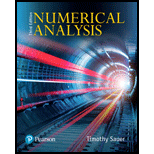
Solve the system by finding the LU factorization and then carrying out the two-step back substitution.
Want to see the full answer?
Check out a sample textbook solution
Chapter 2 Solutions
Numerical Analysis
- 4. The runway at the Piarco International airport has an equation of -3(x-2y) = 6. If the Priority Bus Route passes through the geometric coordinate (1,-9) and is perpendicular to the runway at the Piarco International airport. Determine the following: a. State two geometric coordinates which the runway at the Piarco International airport passes through. b. Derive the equation of the Priority Bus Route. [2 marks] [6 marks]arrow_forwardUse Euler and Heun methods to solve y' = 2y-x, h=0.1, y(0)=0, compute y₁ys, calculate the Abs_Error.arrow_forwardTY D om E h om ng 00 C B A G F Q ו 3 13 Details Find an Euler path for the graph. Enter your response as a sequence of vertices in the order they are visited, for example, ABCDEA. fic ► Question Help: Video Message instructor Submit Question tor arch 園 A Wind advisoryarrow_forward
- The twice differentiable functions fand g are defined for all real numbers of x. Values of f(x) and g(x) for various values of x are given in the table below. Evaluate (f'(g(x))g'(x)dx. -2 X -2 −1 1 3 f(x) 12 8 2 7 g(x) -1 03 1arrow_forwardSuppose we wish to test the hypothesis that women with a sister’s history of breast cancer are at higher risk of developing breast cancer themselves. Suppose we assume that the prevalence rate of breast cancer is 3% among 60- to 64-year-old U.S. women, whereas it is 5% among women with a sister history. We propose to interview 400 women 40 to 64 years of age with a sister history of the disease. What is the power of such a study assuming that the level of significance is 10%? I only need help writing the null and alternative hypotheses.arrow_forwardQ4*) Find the extremals y, z of the the functional I = 1 (2yz - 2x² + y²² 12 - 212) dx, with y(0) = 0, y(1) = 1, z(0) = 0, ≈(1) = 0.arrow_forward
- Solve the following initial value problem over the interval from t= 0 to 2 where y(0)=1. dy yt² - 1.1y dt Using Euler's method with h=0.5 and 0.25.arrow_forwardQ5*) Write down an immediate first integral for the Euler-Lagrange equation for the integral I = = F(x, y, y″) dx. Hence write down a first integral of the Euler-Lagrange equation for the integral I 1 = √(xy ² + x³y²) dx. Find the general solution of this ordinary differential equation, seeking first the complementary function and then the particular integral. (Hint: the ODE is of homogeneous degree. And, for the particular integral, try functions proportional to log x.)arrow_forwardYou are provided with three 2D data points, p1, p2 and p3. Solving A C = B for C provides youwith the coefficients of a natural cubic spline curve that interpolates these points.Additionally, you have been given A and B, but some elements are missing. Moreover, the last two rowsof A are entirely absent. Your task is to determine and fill in the missing elements. For the last two rows,enforce a zero tangent at the beginning (in p1) and a not-a-knot boundary condition in p2. The matricesA and B are given as follows:Explain how to find the entries of A and B . How would you adapt these matrices if the data pointswere 3D? What if your spline should go through five data points? How many “extra rows” would there thenbe (with “extra” meaning “in addition to securing C2-continuity”)?arrow_forward
- Q2*) In question P3 we showed that a minimal surface of revolution is given by revolution (about the x-axis) of the catenary, with equation y = C cosh ((x – B)/C). - (a) Suppose, without loss of generality, that the catenary passes through the initial point P = (x1,y1) = (0, 1). First deduce an expression for the one-parameter family of catenaries passing through point P. Next calculate the value of x at which y takes its minimum value. By using the inequality cosh > √2 (you might like to think about how to prove this), show that there are points Q for which it is impossible to find a catenary passing through both P and Q. In particular, show that it is impossible to find a catenary joining the points (0, 1) and (2, 1). (b) A minimal surface of revolution can be realised experimentally by soap films attached to circular wire frames (see this link and this link for examples). The physical reason for this is that the surface tension, which is proportional to the area, is being minimised.…arrow_forwardQ3*) Consider the integral I Yn, Y₁, Y2, . . ., Y'n) dã, [F(x, Y 1, Y2, · · Yng) = - where y1, 2, ...y are dependent variables, dependent on x. If F is not explicitly dependent on x, deduce the equivalent of the Beltrami identity. Optional: Give an example of a function F(y1, Y2, Y₁, y2), and write down the Euler-Lagrange equations and Beltrami Identity for your example. Does having this Beltrami Identity help solve the problem?arrow_forwardWrite an integral that is approximated by the following Riemann sum. Substitute a into the Riemann sum below where a is the last non-zero digit of your banner ID. You do not need to evaluate the integral. 2000 (10 1 ((10-a) +0.001) (0.001)arrow_forward
 Algebra: Structure And Method, Book 1AlgebraISBN:9780395977224Author:Richard G. Brown, Mary P. Dolciani, Robert H. Sorgenfrey, William L. ColePublisher:McDougal Littell
Algebra: Structure And Method, Book 1AlgebraISBN:9780395977224Author:Richard G. Brown, Mary P. Dolciani, Robert H. Sorgenfrey, William L. ColePublisher:McDougal Littell College Algebra (MindTap Course List)AlgebraISBN:9781305652231Author:R. David Gustafson, Jeff HughesPublisher:Cengage Learning
College Algebra (MindTap Course List)AlgebraISBN:9781305652231Author:R. David Gustafson, Jeff HughesPublisher:Cengage Learning Elementary AlgebraAlgebraISBN:9780998625713Author:Lynn Marecek, MaryAnne Anthony-SmithPublisher:OpenStax - Rice University
Elementary AlgebraAlgebraISBN:9780998625713Author:Lynn Marecek, MaryAnne Anthony-SmithPublisher:OpenStax - Rice University
 Glencoe Algebra 1, Student Edition, 9780079039897...AlgebraISBN:9780079039897Author:CarterPublisher:McGraw Hill
Glencoe Algebra 1, Student Edition, 9780079039897...AlgebraISBN:9780079039897Author:CarterPublisher:McGraw Hill





